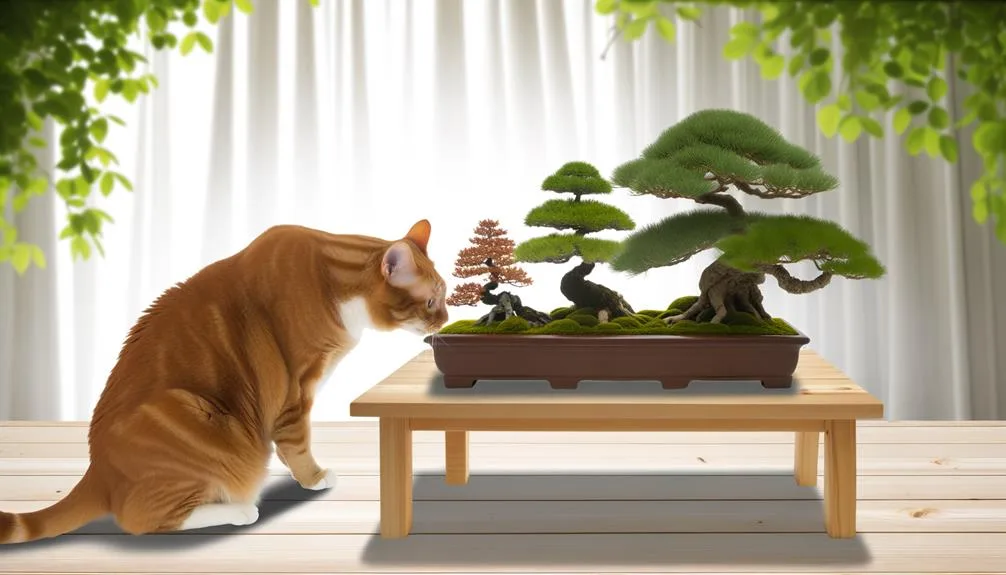Are Bonsai Poisonous to Cats?
Certain bonsai tree species are indeed harmful to cats. Toxic varieties like Sago Palm, Jade Plant, Azalea, and Ficus contain compounds that can lead to severe health issues, such as vomiting, lethargy, and even liver damage.
It is important to recognize symptoms of poisoning, such as excessive salivation and gastrointestinal distress, for prompt veterinary intervention. For pet safety, choose non-toxic bonsai options like Ficus retusa or Japanese Maple, and implement preventive strategies to limit feline access.
Understanding which bonsai trees are safe and how to prevent poisoning will guarantee a harmonious home environment. Explore more about maintaining a pet-friendly bonsai collection.

Key Takeaways
- Sago Palm bonsai are highly toxic to cats, causing severe liver damage.
- Jade Plant bonsai ingestion can lead to vomiting, lethargy, and incoordination in cats.
- Azalea bonsai contain grayanotoxins, which can result in vomiting, diarrhea, and cardiovascular issues in cats.
- Ficus bonsai may cause gastrointestinal distress and dermatitis if ingested by cats.
- Safe alternatives like Ficus retusa and Japanese Maple bonsai are non-toxic to cats.
Common Bonsai Varieties

Several common bonsai varieties, such as Ficus, Jade, and Sago Palm, are frequently cultivated for their aesthetic appeal and manageable size. These species are popular due to their ability to thrive indoors and their relatively low maintenance requirements.
Ficus bonsai, known for their intricate root structures and dense foliage, are particularly favored in both residential and office settings.
Jade bonsai, with their thick, succulent leaves, offer a unique visual texture and are prized for their drought-resistant qualities.
Sago Palm bonsai are admired for their feather-like leaves and symmetrical growth patterns. Understanding the characteristics of these bonsai varieties is essential for enthusiasts and pet owners to guarantee both the well-being of their plants and the safety of their household pets.
Toxic Bonsai Trees
Understanding the toxicological risks associated with certain bonsai trees is vital for ensuring the safety of both pets and humans. Some bonsai species contain compounds that can be harmful if ingested by cats.
The following bonsai varieties are particularly hazardous:
- Sago Palm (Cycas revoluta): Contains cycasin, which can cause severe liver damage.
- Jade Plant (Crassula ovata): Ingestion may lead to vomiting, lethargy, and incoordination.
- Azalea (Rhododendron spp.): Contains grayanotoxins, which can result in vomiting, diarrhea, and cardiovascular issues.
- Ficus (Ficus spp.): Can cause gastrointestinal distress and dermatitis.
It is essential for bonsai enthusiasts to identify and avoid these toxic varieties to protect their feline companions. Proper knowledge and preventive measures can mitigate the risks associated with these plants.
Safe Bonsai Options

For bonsai enthusiasts concerned about the safety of their feline companions, selecting non-toxic bonsai species is paramount. Evidence-based recommendations highlight several species that are deemed safe for cats.
Ficus bonsai, including Ficus retusa and Ficus benjamina, are excellent options, as they are non-toxic to felines. Similarly, the Japanese Maple (Acer palmatum) and the Bamboo Palm (Chamaedorea elegans) present minimal risk of toxicity.
Additionally, the Dwarf Jade (Portulacaria afra) is considered safe and can be a visually appealing choice. Ensuring the safety of these bonsai species mitigates the risk of accidental poisoning, thereby fostering a harmonious environment for both plant and pet.
Selecting these non-toxic varieties will help cat owners maintain a pet-friendly and aesthetically pleasing home.
Symptoms of Poisoning
When a cat ingests parts of a toxic bonsai, common symptoms of poisoning may include vomiting, diarrhea, lethargy, and excessive salivation. Prompt identification of these signs is vital, as immediate veterinary intervention can greatly impact the prognosis.
Owners should be prepared to follow urgent care steps, such as contacting a veterinarian and providing any available information on the ingested plant.
Common Poisoning Symptoms
Many cats exposed to toxic bonsai plants exhibit a range of common poisoning symptoms, including vomiting, diarrhea, lethargy, and loss of appetite. These symptoms often arise shortly after ingestion and can vary in severity depending upon the type and amount of the bonsai plant consumed.
Common clinical signs indicative of poisoning in cats include:
- Vomiting: Often the first sign, indicating gastrointestinal distress.
- Diarrhea: Results from irritation of the intestinal tract.
- Lethargy: A general lack of energy, often accompanied by weakness.
- Loss of appetite: Refusal to eat, potentially leading to weight loss.
Prompt recognition of these symptoms is vital for timely intervention. Understanding these clinical signs aids in determining the appropriate course of action to protect feline health.
Urgent Care Steps
Immediate and appropriate urgent care steps are crucial in mitigating the effects of bonsai poisoning in cats.
Upon suspecting ingestion, immediately remove any plant material from the cat's mouth and initiate contact with a veterinarian or a pet poison helpline. Symptoms such as vomiting, diarrhea, lethargy, and drooling warrant swift action.
Do not induce vomiting without veterinary guidance, as this can worsen the situation. Transport the cat to a veterinary facility promptly, where supportive care, including intravenous fluids and activated charcoal, may be administered to limit toxin absorption.
Timely intervention can greatly improve prognosis. Maintaining a calm demeanor and providing clear information about the ingested plant can facilitate effective and efficient treatment.
Preventing Cat Poisoning

Effective prevention of cat poisoning involves understanding the specific toxic properties of bonsai species and implementing measures to limit feline access to these plants.
Ensuring a safe environment for cats requires vigilance and strategic planning. To mitigate risks, consider the following steps:
- Identify Toxic Species: Familiarize yourself with bonsai species known to be toxic to cats, such as Juniper, Azalea, and Sago Palm.
- Physical Barriers: Utilize barriers such as plant cages or elevated shelves to keep bonsai out of reach.
- Alternative Locations: Place bonsai plants in rooms that are off-limits to pets.
- Behavioral Training: Train cats to avoid certain areas using positive reinforcement techniques.
These proactive measures can greatly reduce the risk of accidental poisoning while allowing the coexistence of bonsai and feline companions.
Pet-Friendly Alternatives
For cat owners who wish to enjoy the beauty of bonsai without risking their pet's health, choosing pet-friendly alternatives is an important and effective approach. Certain bonsai species such as the Baby Jade (Portulacaria afra) and the Japanese Maple (Acer palmatum) are considered non-toxic to cats.
Additionally, opting for non-toxic indoor plants like the Spider Plant (Chlorophytum comosum) or the Areca Palm (Dypsis lutescens) can provide similar aesthetic value without the associated risks.
It is vital to verify the safety of any plant species before introducing it into a home with pets. Consulting resources such as the ASPCA's toxic and non-toxic plant lists can provide valuable guidance in selecting safe alternatives.
Conclusion
To sum up, the careful selection of bonsai varieties is vital to safeguarding feline health, as certain species possess toxic properties that can result in severe poisoning. Recognizing symptoms and implementing preventive measures are essential to mitigate risks.
Pet-friendly alternatives provide a safe haven for both plants and pets, ensuring a harmonious coexistence. Therefore, diligence in choosing non-toxic bonsai trees can be the silver lining that secures the well-being of beloved feline companions.






